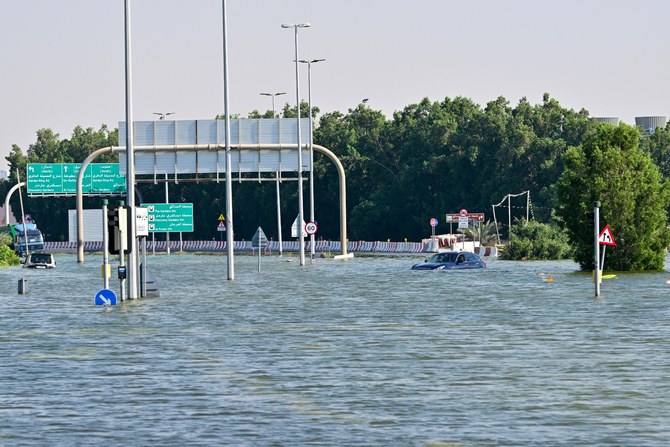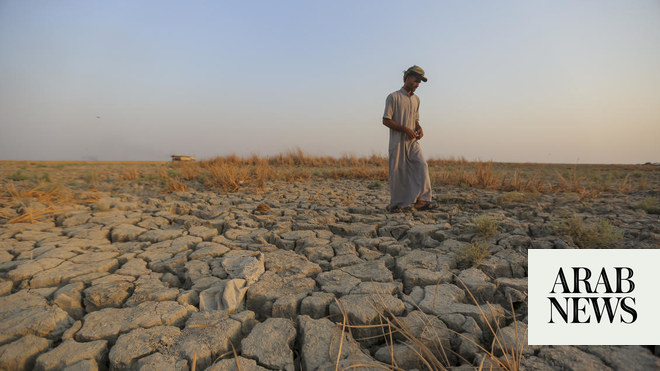
The opposite ends of the Arab world are experiencing two extreme weather conditions simultaneously: while the UAE and Oman in the east recover from last week’s unprecedented rain and flash floods, Morocco in the west is experiencing its sixth continuous year of drought.
Flooding killed at least four people in the UAE and 20 in Oman, while others face clean water shortages, travel disruptions and power and internet outages. In Morocco, persistent drought-like conditions have reduced water levels, significantly impacted the country’s agricultural production potential and led to unemployment and overcrowding in urban areas. With the country seeing a 70 percent reduction in rainfall over the past eight months, dry tracts of land have damaged crop yields, which in turn impacts the country’s export revenue.
Climate change is the common link between the extremes of flash floods and droughts. The Middle East and North Africa region is warming twice as fast as the global average and could be 4 degrees Celsius hotter by 2050. Rising temperatures have resulted in heat waves, erratic rainfall and a reduction in the amount of arable land. Moreover, the Arabian Gulf is the hottest sea in the world, posing an ever-increasing threat to marine biodiversity.
Another notable climate challenge in the region is the impending collapse of the Gulf Stream weather system, which could take place between 2025 and 2095. It is alarming that the high rate of warming has left the region facing two opposite and unpredictable consequences: extreme heating and extreme rainfall and flooding.
It is alarming that the high rate of warming has left the region facing two opposite and unpredictable consequences
Zaid M. Belbagi
Three of the region’s most important rivers — the Nile, the Tigris and the Euphrates — have had lower water levels in recent years. According to studies, the flow of the Nile has, over the last five decades, reduced from 3,000 cubic meters per second to 2,830 cubic meters. Forecasts show that this flow reduction may reach 70 percent by 2100 if the present conditions persist. Similarly, the Tigris-Euphrates river system faces the risk of drying up by 2040.
While dams, the mismanagement of wastewater and unsustainable agricultural and industrial practices are contributory factors, climate change is the primary driving force. Drought-like conditions and high temperatures have resulted in these rivers slowly drying up.
The recent flooding in the UAE and Oman has drawn attention to two aspects of the preparedness required to address the consequences of climate change. Firstly, countries must account for climate adversities in their urban planning. Given the typically low levels of rainfall in the Gulf, the existing infrastructure was unable to bear the volume of water flow, as sewage drains overflowed and electricity grids failed.
In recent years, Dubai has frequently upgraded its drainage management system prior to the November-March period, when it tends to receive rain. Yet, unprecedented weather changes call for further investment in climate-resilient infrastructure across the region. This is particularly important given the dual challenge of increasing rainfall and rising temperatures.
The latest freak weather events highlight the need to earmark funds to mitigate the impact of climate change
Zaid M. Belbagi
The latest freak weather events also highlight the need to earmark the necessary funds to mitigate the impact of climate change. Global temperatures are rising rapidly and leading to climate-related adversities, meaning regular investment in mitigation strategies is required. The MENA region has typically received a minority share of global climate financing despite being one of the most vulnerable to climate change. A mere 6.6 percent of the total financing in 2023 from the three largest international climate funds — the Green Climate Fund, the Global Environment Facility and the Climate Investment Funds — went to the region. Moreover, these limited funds are distributed unequally across the region, with the vast majority going to Morocco and Egypt, along with Tunisia and Jordan.
It is imperative that international organizations and global climate financiers turn their attention toward mitigating environmental adversities in the MENA region. Any significant alteration in the climate here will consequently impact the climate of neighboring regions. MENA countries have actively participated in international environment conferences such as COP28 and MENA Climate Week. However, there remains an urgent need to divert more climate financing to the region and share best practices to establish climate-resilient infrastructure.
Further, climate change has a tangible impact on the economy. A few days of disarray at Dubai International Airport due to the flooding have significantly disrupted international travel, given the centrality of Dubai’s airspace in connecting continents. Similarly, shortfalls in Moroccan agricultural production can cause food shortages in Europe, given the continent’s dependence on Morocco for the import of goods.
Most importantly, the economic impact of climate change will be felt most by the youth of the region, as employment opportunities reduce and the quality of life weakens. Thus, the region must build a robust climate change mitigation strategy, with the support of the international community, to ensure its ongoing socioeconomic development does not fall prey to environmental risks.
Zaid M. Belbagi is a political commentator and an adviser to private clients between London and the Gulf Cooperation Council region. X: @Moulay_Zaid












